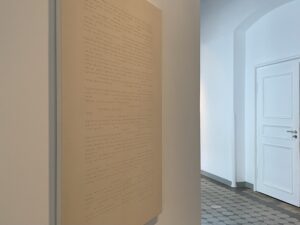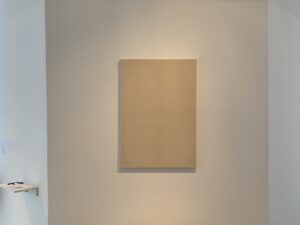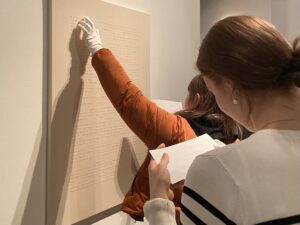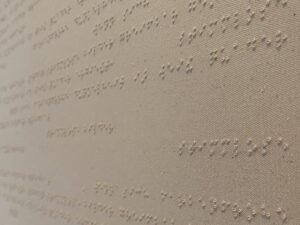To start the week, we have a very special eye-catcher for you – or should I say, a touch-catcher?
Justine Herbst blurs the boundaries between canvas art and Braille in her work, making art tangible in a whole new way.
Thank you, Justine, for sharing your impressive creation with us!
Introduction
My name is Justine Herbst, and I am a student teacher specializing in Art and English at TU Dresden.
I am not blind myself, but my work with my blind students inspired me to engage with Braille and the topic of inclusion in the context of art and art exhibitions.
The result is the artwork Knotenpunkte (“Nodes”), a 70×100 cm canvas on which Braille dots have been embroidered using atheism French knot stitch.
It was part of the art education exhibition in the winter semester 2024/25 at the Görges-Bau of the University of Technology Dresden.
Visitors were invited to explore the piece through touch. Additionally, informational flyers from the organization Aktion Mensch were provided to introduce sighted visitors to Braille.
The canvas features the following German text in Braille:
“wenn sich farbenfrohe dunkelheit in weiße quader ergießt, werden stimmlose bilder greifbar gemacht.””(When colorful darkness pours into white rectangles, voiceless images are made tangible.”)
Accompanying text
Knotenpunkte (Nodes)
100 x 70 x 2 cm
Embroidery thread on unprimed canvas
The artwork “Knotenpunkte” (“Nodes”) by German artist Justine Herbst addresses the societal marginalization of individuals with visual impairments within the museum context.
Starting from the question of how art becomes accessible when visual stimuli are not available, it opens up an alternative level of perception: haptics.
On the unprimed canvas, the recurring poetic phrase “wenn sich farbenfrohe dunkelheit in weiße quader ergießt, werden stimmlose bilder greifbar gemacht.” (“when colorful darkness pours into white cubes, voiceless images are made tangible.”) is embroidered in Braille. Through this tactile implementation, language becomes palpable. The work encourages understanding art beyond the sense of sight—through touch, imagination, and empathy.
It is directed at both sighted and blind individuals and advocates for art that is multisensorial and breaks down barriers. “Knotenpunkte” invites viewers to feel the invisible.





Ein echter Hinfühler
Zum Start in die Woche haben wir heute einen ganz besonderen Hingucker für euch – oder sollte ich besser sagen: einen Hinfühler?
Justine Herbst lässt in ihrem Werk die Grenzen zwischen Leinwandkunst und Brailleschrift verschwimmen und macht Kunst auf eine ganz neue Weise erlebbar.
Vielen Dank, Justine, dass du deine beeindruckende Arbeit mit uns teilst und vor allem auch für das schöne Bildmaterial, dass wir euch allen auf Facebook und Livingbraille zur Verfügung stellen.
Vorstellung
Mein Name ist Justine Herbst und ich bin Lehramtsstudentin für die Fächer Kunst und Englisch an der TU Dresden.
Ich selber bin nicht blind, doch inspirierte mich die Arbeit mit meinen blinden Schüler*innen dazu mich mit Brailleschrift und Inklusion im musealen Kontext auseinanderzusetzen.
Das Resultat ist das Werk „Knotenpunkte,“ eine 70×100 cm große Leinwand auf welche Braille-Punkte im Knötchen-Stich gestickt wurden. Es wurde in der Examensausstellung der Kunstpädagogik im Görges-Bau der TU Dresden ausgestellt. Die Besucher wurden dabei dazu eingeladen das Werk haptisch zu erkunden. Außerdem wurden Flyer der Aktion Mensch zur Erkundung der Braille-Schrift bereitgelegt um einen Zugang für sehende Besucher zu schaffen.
Auf der Leinwand steht in Braille Schrift: „wenn sich farbenfrohe dunkelheit in weiße quader ergießt, werden stimmlose Bilder greifbar gemacht.“
Begleittext
Knotenpunkte (Nodes)
100 x 70 x 2 cm
Stickgarn auf ungrundierter Leinwand
Das Kunstwerk Knotenpunkte der deutschen Künstlerin Justine Herbst thematisiert die gesellschaftliche Marginalisierung von Menschen mit Sehbeeinträchtigungen im musealen Kontext.
Ausgehend von der Frage, wie Kunst zugänglich wird, wenn visuelle Reize nicht verfügbar sind, eröffnet es eine alternative Wahrnehmungsebene: die Haptik.
Auf der ungrundierten Leinwand ist der wiederkehrende poetische Satz „wenn sich farbenfrohe dunkelheit in weiße quader ergießt, werden stimmlose bilder greifbar gemacht.“ in Brailleschrift eingestickt. Durch diese taktile Umsetzung wird Sprache spürbar. Das Werk regt dazu an, Kunst jenseits des Sehens zu erfahren – durch Berührung, Vorstellungskraft und Empathie.
Es richtet sich sowohl an sehende als auch an blinde Menschen und setzt sich für eine multisensorische Kunst ein, die Barrieren abbaut. Knotenpunkte lädt die Betrachtenden dazu ein, das Unsichtbare zu fühlen.
useful links:
Read all articles on: livingbraille.eu
Contact us with your contributions, ideas and questions by: braille200@livingbraille.eu
Social media: Braille 200 on Facebook